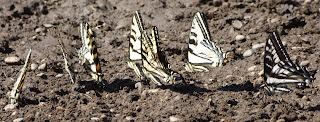A Great Blue Heron sat up there regally many a morning.
Turkey Vultures used it for a perch... in fact, yesterday two were on it. Some days there were lots more than two...
An Osprey sat there once and a Red-shouldered Hawk a time or two...
 |
| Red-shouldered Hawk |
... a Peregrine Falcon... and many, many Red-tailed Hawks...
The only Acorn Woodpecker I've ever seen here poked around at its top...
with a Kestrel watching... for a time. Wondering, I'm sure, what that strange bird was doing on *his* (the Kestrel's) snag.
A few times a year, a Bald Eagle posed on top. The day after the below photo was taken with an adult eagle on the broad top, a sub-adult eagle tried to land on that skinny point next to the broad top. It never could balance on that point but it kept trying.
As the tree rotted more and more, pieces broke off, leaving the top looking different from month to month. But always very tall, providing a wonderful lookout tower for the birds.
Birds have nested in the holes that its rotting limbs created. Raccoons slept in those holes. A college class got to see two of them curled up together high above just a year or two ago.
So many birds used the top as a perch that I moved one of my scopes down to Johnny's machine shed to be closer and had it set so I could just move it a few feet outside and it would be aimed at the top. I have taken a zillion photos of that snag with its occupants. Now the skyline looks bare without it. How will the hawks react, I wonder, when they fly in to find it gone?
To take this photo today, I stood where I set my scope to look at the snag... which is no longer there.
After all this steaming hot weather, it was a joy to hear the thunder roll this morning as I sat up in the horse barn loft measuring out hay cubes for the horses. Then rain began to fall on the roof... what a wonderful sound! But the rain didn't amount to much. Still, it cooled and cleared the air. After feeding the horses, I cleaned their paddock as usual into my EZ Go, enjoying the cool breeze and the very occasional rain drop. Then I drove the EZ Go to the field adjacent to the little creek and the big snag that stood over it, the field where I spread manure every morning.
Just as I started into the field I heard a tremendous crashing in the trees by the creek. I looked just in time to see the last descent of the snag as it fell through the trees and across the creek and the culvert crossing.
Suddenly, there was no snag on the skyline.
I called Johnny and he came out to see. It was completely blocking the culvert crossing. The horses would not be going into their lower field today. This is the shaky photo I took when I first arrived at the scene. Although I knew it was destined to fall, it was still hard to believe it was really gone.
Johnny, being less sentimental, went right to work sawing the snag into a piece that could be towed off the crossing with the tractor.
He towed it to a spot alongside the path... a place to sit and rest, he said.
I crawled through the brush to where it had stood. Just a stump was left with the rest in pieces lying across trees and the culvert and into the creek.
The rings on the stump told a tale of rapid early growth, followed by slower growth, interspersed with good years of wide rings and not-so-good years of narrower rings. The newest growth rings were very narrow. It had slowed down considerably in its old age.
The core of the stump was completely rotted out but I found a hunk of it lying nearby. Look how wide those rings are, back in the fir's youth.
An interesting set of very narrow rings were in the middle of wider rings (photo below), showing a couple years of severely stunted growth. I wonder what caused that?
Ah, the tales that tree could tell... of birds and other wildlife in its boughs... of good years and bad years. I started to count the rings but could not finish because so much of the core is gone... The rings that remain tell me it was at least 200 years old.
It's like having an old friend die. That snag has watched over our farm forever. But nothing lasts forever. Goodbye, old friend.


























































